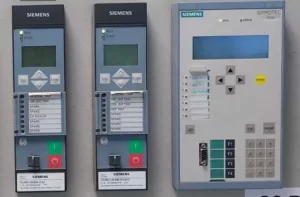OLTC stands for On-load tap changer which is used in Transformer to regulate the output voltage. OLTC is installed inside the transformer main tank. It is operated by a Drive mechanism which is connected to OLTC through a tie rod. Generally, the Drive mechanism is mounted on the outside body of the Transformer.
Based on the requirement of output voltage, OLTC operates by the drive mechanism in a manual or automatic way through AVR (Automatic Voltage Regulating). Generally in Power Transformer, AVR relay is used in RTCC (Remote Tap Changer Control) panel. As per the command of AVR relay, the OLTC operates to change the voltage to Raise or lower direction.
Purpose of OLTC in Transformer
As we know Transformer is used in Power System to step up or step down of the voltage. If the Transformer is designed at a fixed ratio, there will be no provision for changing of output voltage. The OLTC or On-load Tap Changer is required in Power Transformer for the following reasons.
- Variation of Distribution Load: The demand of load at the distribution section is not constant; it will vary at different times of the day. The output voltage of the transformer goes down due to high load during peak demand and the voltage goes up during low demand time. The changing of the output voltage is not healthy for the connected loads and stability of the Grid. In this case, the output voltage is regulated by the OLTC by changing the transformer Tap position.
- Inductive or Capacitive Load: In addition to changing load demand there are different types of loads are connected to the distribution grid. Due to using of higher inductive load like Motor, Fan, Pump, Chocks, relay, contactors, etc., the output voltage dropped. For using Capacitive loads like capacitor banks, Synchronous motor, Buried cable, Radio circuits,s etc., the output voltage increased.
- Grid Stability: The voltage of the power system also varies due to various reasons like long length transmission lines, use of FSC, and reactors in substations. Variation of Transformer output voltage is also required for better stability of Transmission and distribution power grid.
Working Principle & connection diagram of OLTC or On-Load Tap Changer
OLTC consists of two separate sections, they are Diverter switch and Tap selection. The diverter switch is a separate housing inside the transformer. The diverter switch is filled with transformer oil and a separate conservatory is used for it.
During changing of the tap from one tap position to another position, the neutral or phase connection can be discontinued for a moment. A resister unit is used in parallel with the main tap to avoid discontinuity during the changeover of the tap position.
The following connection diagram of OLTC, it is explained the working principle of OLTC in Transformer.

In the connection diagram of Fig-I, OLTC tap position is connected to the Tap-2. The load current flows through the OLTC selector contact U. Due to the high resistive path of X, the resistive path is automatically bypassed.
At this point, we need to change OLTC tap position from Tap-2 to Tap-3. At present, all load current flowing through the main contact U and there is no load in Main contact V.

After receiving the tap changing command, the main contact V is shifted from Tap-1 to Tap-3 and the selector contact is connected to points X & Y and it is disconnected from main contact U. At the present moment, the load current flows through the resistance X & Y.

After the position as mentioned in fig-2, it is moved to the position as in Fig-3. Here, the selector contact is connected to the main contact V and the resistor contact Y. In this condition, the load current flows through main contact V and the tap position 3. After shifting the selector contact to the V and X, the resistor contact will automatically be bypassed due to the high resistive path as compared to the main contact.
In this way, the OLTC changes the tap position and there is no discontinuity of current. The above change over in OLTC is done very fast to avoid the arc during changing of contacts. generally within 50 ms, the complete sequence is done in OLTC.


Be First to Comment